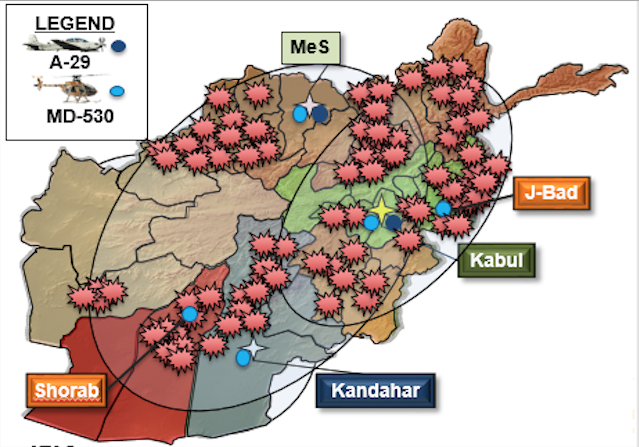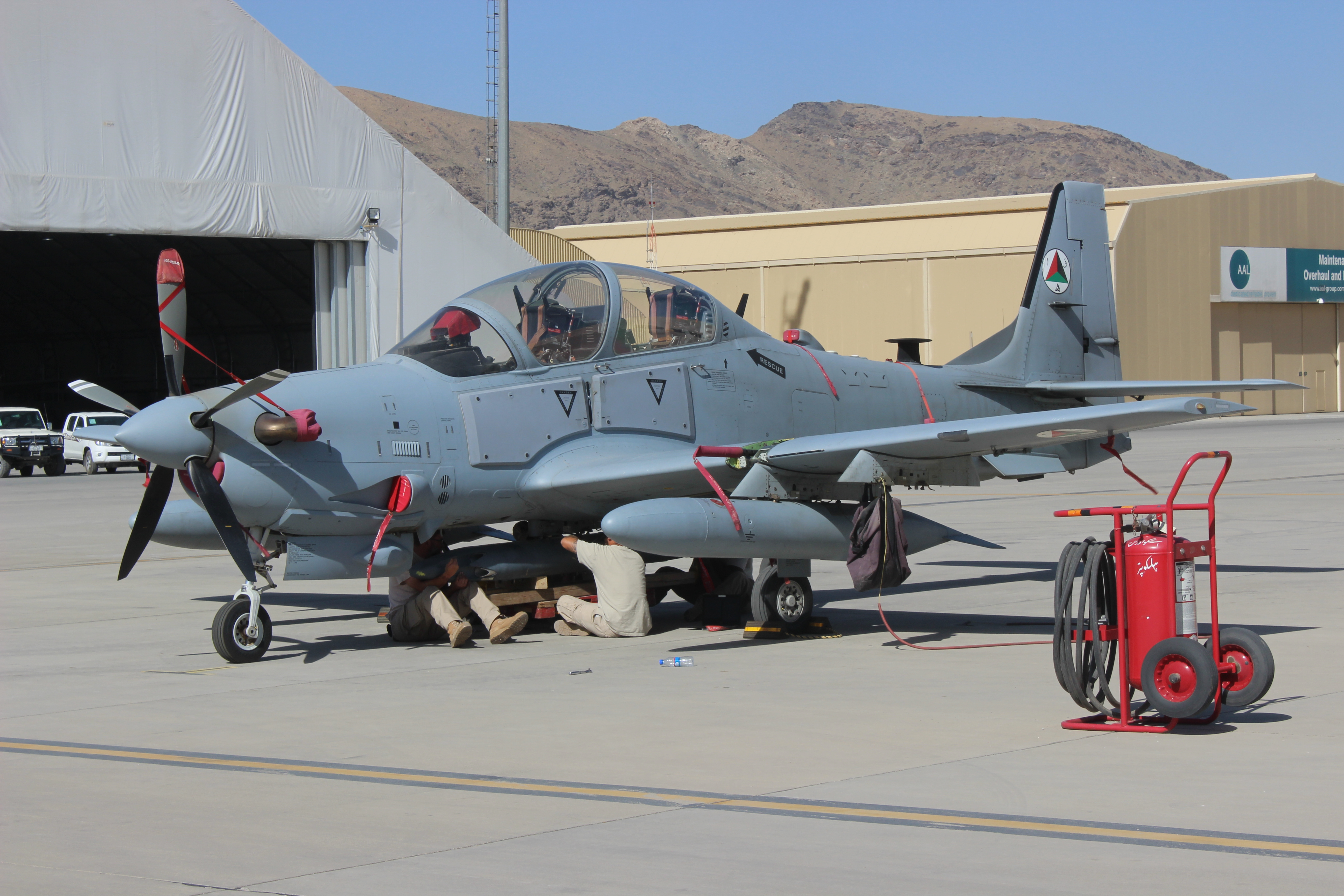US contractors work on an Afghan Air Force A-29 Super Tucano on the flightline at Hamid Karzai International Airport in Kabul. Staff photo by Brian Everstine. The map below indicates airstrikes conducted by Afghan Air Force A-29 and MD-530 aircraft in 2016. The blue dots represent operating locations for the aircraft. Graphic courtesy of the 438th Air Expeditionary Wing.
KABUL—Since conducting its first combat strike last year, the Afghan Air Force’s most capable combat aircraft is preparing to be the cornerstone of the advance against the Taliban while, at the same time, USAF advisers are pushing to train more.
The Afghan Air Force now flies 12 A-29 Super Tucanos, with just 13 qualified aircrew. The aircraft flew its first combat strike in April 2016, and accounted for 138 total strikes in 2016.
“Every corps that’s out there wants the A-29’s support,” USAF Lt. Col. Johnnie Green, commander of the 438th Air Expeditionary Advisory Squadron, told Air Force Magazine during a recent visit here. The squadron, based at FOB Oqab, attached to Hamid Karzai International Airport, is responsible for training and advising both Afghan Air Force A-29 and MD-530 attack helicopter squadrons.
“The difficult terrain, the amount of operations that are going on throughout the country, the A-29 provides that … attack aircraft capability that they didn’t have necessarily before,” Green said.
The A-29s operate out of three locations, with Kabul being the main site of training and two forward operating locations in the country serving as launching points for combat operations.
USAF trains A-29 pilots at Moody AFB, Ga., for about a year before the pilots return to Afghanistan. In Kabul, the pilots fly their first solo flight and their first live weapons drop before going straight into combat.
“These guys come out of Moody, do an in-theater checkout, and go right into combat, killing the Taliban,” said Col. Lendy Renegar, the chief of staff for the 438th Air Expeditionary Wing in Kabul.

The training contingent, both at Moody and in Kabul, is largely made up of former USAF A-10 pilots who are most familiar with the close air support role.
“They come out with a very western attitude, very well trained,” said USAF Maj. Gen. James Hecker, the commander of the 9th Air and Space Expeditionary Task Force-Afghanistan and commander of NATO Air Command-Afghanistan. “They are very sensitive to civilian casualties and making sure there’s little to no collateral damage.”
The USAF members of the Train, Advise, Assist Command-Air in Afghanistan have to balance the need to train more A-29 pilots with the requirement that the aircraft must fill in the battlefield.
“We are aircraft limited,” Green said. “The aircraft priority has to go to combat. It has to.”
To address this, USAF advisers and Afghan pilots took advantage of the winter lull in fighting as much as possible. This past winter, the pilots and trainers focused on building new capabilities that weren’t necessarily fully addressed during initial training, such as night flying.
“We make sure that we are building and progressing toward night capability,” Green said, explaining that it will take about three years to have aircrews fully qualified on night vision goggles. The pilots flew a familiarization flight at night at Moody, but it will take extensive training to fully be able to fly close air support at night.
USAF advisers are also working on developing the pilots’ proficiency at dynamic targeting—being able to adjust their targets and plans while on a mission.
“What we’re trying to do is build a healthy, experienced base,” Renegar said. “We’re moving at a pace we’re comfortable with. They take to these things way better than we give them credit for sometimes.”
In addition to the need for more pilots, USAF is developing a long term plan for Afghan Air Force A-29 maintainers. Currently, about 80 percent of the maintainers are US contractors, and 20 percent are Afghan service members. Within four years, TAAC-Air wants to switch those numbers.
“It takes time,” Renegar said. “It takes patience to build a pilot, it takes patience to build a maintainer.”
While the supply chain for the Sierra Nevada Corp.-made A-29 may never be Afghan, more Afghan maintainers are in training. At the Kabul base, almost all A-29 maintenance is done by American contractors. However, at the forward operating location near the city of Mazar-e-Sharif in the north, the maintenance support is 100 percent Afghan, Green said.
“It’s just a numbers game, we don’t have the numbers of maintainers yet to make that shift,” he said. “As maintenance trained Afghans come into country, we are pushing them out to FOLs [Forward Operating Locations] and they start operating on their own. They will start developing experience just as pilots do.”
While the US mission in Afghanistan is nearing 16 years, the mission to build up the Afghan Air Force is much younger. The A-29 has just over one year in combat. The MD-530 has been operational for about 16 months. There is a lot more work for USAF advisers to do, to build the pilot, maintainer, ground controller, and operations center personnel to be able to take the fight on their own.
US advisers like to say their duty is to “work themselves out of a job,” and there has been momentum building, even if there is still a long way to go.
Green pointed to a recent mission, which took place about two weeks ago. An Afghan air liaison officer was embedded with an Afghan National Army corps in contact with the Taliban. The officer, coordinating with the Afghan Ministry of Defense Air Command and Control Center, requested an airstrike from an Afghan pilot. The strike was so effective, the pilot said it was one of the best products he’d seen.
“That’s that whole circle coming around,” Green said. “We want to get them to do this on a sustainable level, where they can do this themselves. We don’t want to be hands on here …. We want them to be able to execute.”
There is still a large shortfall in the pilot and maintainer ranks, and only a dozen aircraft operational, though the plan is to have a total fleet of 19 aircraft. The Afghan pilots also still make mistakes, but the capability is growing.
“Ultimately they all want to get to the point where, yes, they are professional, they are sustainable. They want to be able to operate on their own,” Green said. “They take a lot of pride in what they’re doing.”

